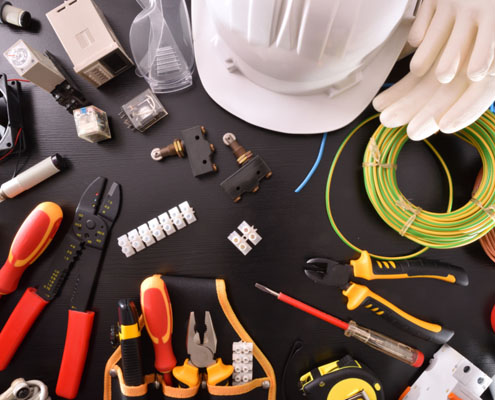Cutting-Edge Innovation with BRE Automation Australia Services
Cutting-Edge Innovation with BRE Automation Australia Services
Blog Article
The Ultimate Guide to Electric Setup: Tips and Strategies for a Safe and Efficient Home Electrical Wiring System
In the world of home upkeep, few facets are as vital yet typically forgotten as the electrical circuitry system. By checking out the subtleties of electrical security procedures and energy-saving practices, this thorough guide will certainly drop light on the complexities of home wiring, encouraging individuals to take cost of their house's electric facilities.
Understanding Electric Safety Actions
To ensure the security of both people and home, understanding and carrying out appropriate electric security procedures is critical in any home circuitry task. Electrical power is a powerful force that can be unsafe if not handled with caution. Among the basic precaution is making certain that all electrical work is performed by qualified professionals that comply with local structure codes and policies. It is important to carry out a complete evaluation of the electrical system before starting any kind of electrical wiring job to identify prospective threats or concerns that require to be addressed.
Furthermore, making use of the ideal tools and equipment is crucial for maintaining safety and security throughout electric installments. Insulated handwear covers, voltage testers, and safety eyewear are several of the fundamental safety equipment that must be worn to avoid electric shocks or mishaps. It is also crucial to de-energize circuits prior to working on them and to label all circuits and breakers clearly to prevent complication.

Necessary Tools for Home Electrical Wiring
Making sure the proper execution of electrical security actions in home electrical wiring projects entails utilizing a particular collection of essential tools created to facilitate the setup process properly and safely. Some of the secret tools required for home wiring jobs include a voltage tester for checking real-time wires, wire strippers for removing insulation from wires, a cord cutter for specifically reducing cables to length, a screwdriver set for safeguarding electrical elements, electric tape for insulation and securing connections, a cable television ripper for stripping cable sheathing, and a multimeter for measuring voltage, present, and resistance.
Step-by-Step Electrical Installation Guide
Beginning an electrical setup project calls for meticulous preparation and adherence to security standards. Prior to starting any work, guarantee you have a comprehensive plan outlining the layout of the electric system, including the placement of electrical outlets, switches, and components. Take right into account the power requirements of each tool to establish the ideal wire scale and circuit breaker dimensions.
The very first action in the setup procedure is to close off the power supply to the location where you will be working. Utilize a voltage tester to validate that the circuits are de-energized before touching any kind of wires. Next, meticulously eliminate existing components or outlets and disconnect the cables.
When mounting new wiring, run cable televisions with walls and ceilings, safeguarding them in location with appropriate fittings. Comply with regional building ordinance and producer guidelines for proper cord setup and connections. BRE Services. Make certain to identify cords for simple identification and future upkeep

Troubleshooting Common Circuitry Issues
Having actually completed the installment process as detailed in the previous subtopic, fixing usual circuitry issues is a necessary skill for ensuring the security and capability of your electric system. One typical concern is a tripped breaker, usually brought on by overloaded circuits or a website here short circuit. To repair this, find the breaker panel, determine the stumbled breaker by trying to find the one not fully in the "on" position, and reset it by turning it completely to "off" and after that back to "on." An additional prevalent problem is a defective outlet, defined by no power or intermittent power supply. Guarantee the outlet is not controlled by a switch, after that utilize a voltage tester to check for power. If there is no power, switch off the circuit, inspect the wiring connections for any type of loose or damaged cords, and change the electrical outlet if required. Continually flickering lights can suggest loose wiring connections or an overloaded circuit. To resolve this, check and tighten all wire links in the influenced fixtures and buttons and redistribute the lots on the circuit to balance the electrical need. On a regular basis evaluating and quickly addressing these common electrical wiring issues will preserve the safety and efficiency of your home electrical system.
Tips for Energy-saving Electric Solutions
For optimum power performance in electric systems, carrying out wise techniques and making use of energy-saving technologies is extremely important. One essential tip for attaining an energy-efficient electrical system is to update to LED lights. Proper insulation and sealing of home windows, doors, and electric outlets can likewise stop energy loss, eventually lowering the work on electrical systems.
Conclusion
To conclude, carrying out proper security measures, utilizing essential tools, adhering to a step-by-step setup guide, troubleshooting typical concerns, and including energy-efficient ideas are vital for a risk-free and efficient home circuitry system. By sticking to these techniques, home owners can guarantee read here the longevity and capability of look here their electrical installations. It is essential to focus on safety and performance when it comes to electric operate in order to avoid possible risks and to keep a reputable electrical system in the home.
Report this page